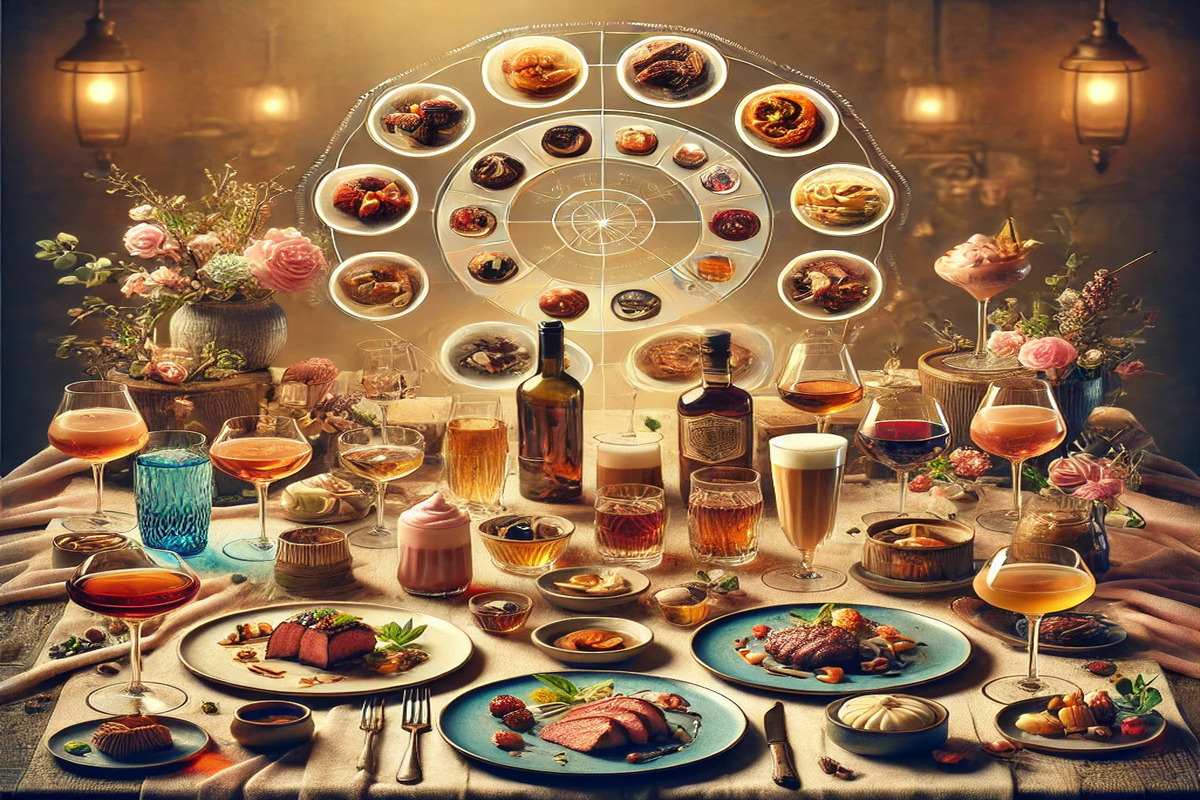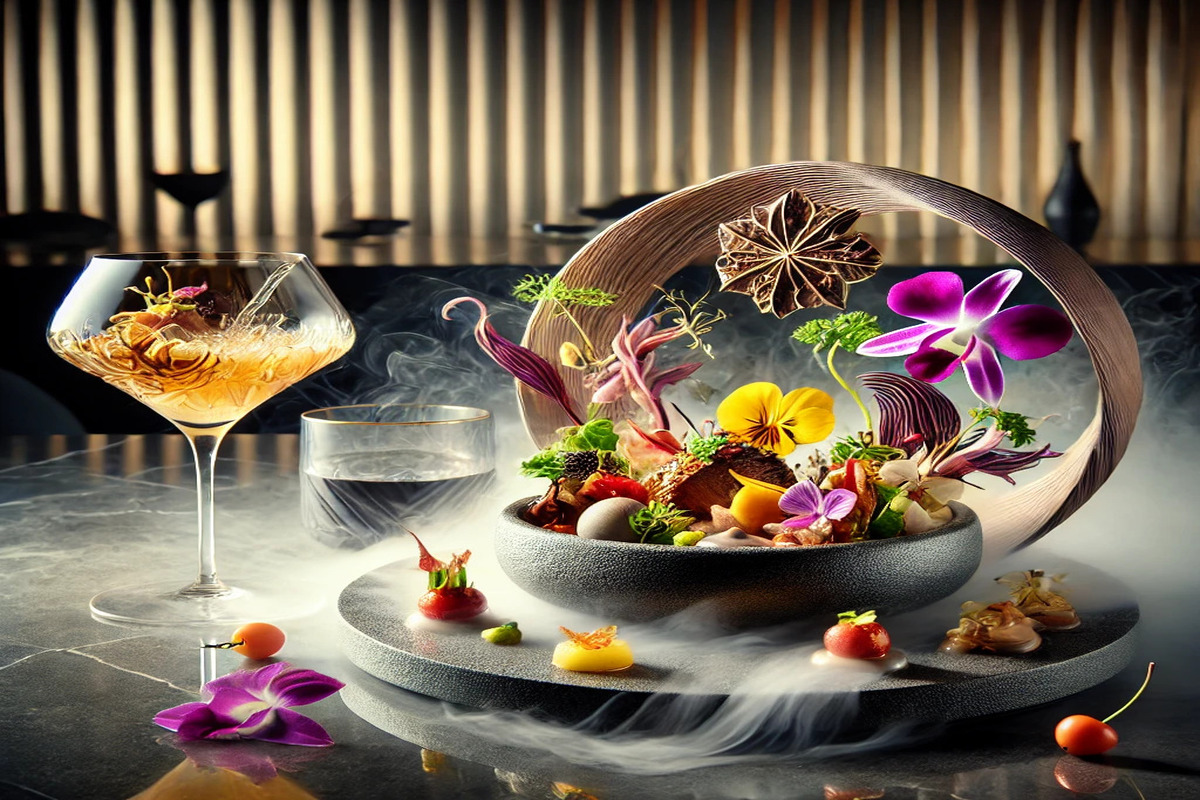In the world of culinary arts, the pairing of food and beverages is an intricate dance of flavors and textures, designed to elevate the dining experience. Read More
In the United States, the trend of food and beverage pairing has embraced bold and inventive combinations. Craft cocktails and artisanal beverages have surged in popularity, with mixologists pushing the boundaries of traditional pairings. American cocktail culture often emphasizes local and seasonal ingredients, resulting in unique flavor profiles that reflect regional tastes. For example, in the Pacific Northwest, you might find cocktails that pair fresh seafood with herbal infusions or fruits like blackberries and rhubarb. On the other hand, Southern cuisine might be paired with cocktails featuring bold flavors like bourbon, complemented by spiced fruits or savory herbs. The rise of craft breweries has also led to innovative pairings, with brews designed to match with specific dishes, such as a hoppy IPA with spicy BBQ or a rich stout with chocolate desserts. Additionally, the American trend towards health and wellness has brought about a rise in non-alcoholic beverages and kombucha pairings. These health-conscious options are often paired with light, fresh dishes like salads or grilled vegetables, offering a refreshing alternative to traditional alcohol-based pairings. Asia’s approach to food and beverage pairing often emphasizes harmony and balance, reflecting the region’s culinary philosophies. In countries like Japan, China, and Thailand, the focus is on achieving a delicate balance of flavors and enhancing the dining experience with subtlety and sophistication. In Japan, traditional tea ceremonies showcase the art of pairing matcha with sweets such as mochi or wagashi. The bitterness of matcha complements the sweetness and texture of these confections, creating a harmonious tasting experience. Similarly, in Chinese cuisine, tea is paired with dim sum, where the flavors of the tea help to cleanse the palate between the rich, savory bites. In Thailand, the trend of pairing beverages with street food highlights a fusion of flavors that reflects the vibrant street food culture. Thai iced tea, with its creamy and spiced profile, is often paired with dishes like spicy pad Thai or mango sticky rice, offering a refreshing counterbalance to the heat and complexity of the food. Europe’s food and beverage pairing trends often blend tradition with contemporary flair, reflecting the region’s rich culinary heritage and innovative spirit. Each country brings its own unique approach, resulting in a fascinating array of pairings that celebrate both classic and modern flavors. In France, wine pairing remains a central aspect of dining culture, with traditional pairings like Bordeaux with red meats or Champagne with seafood. However, contemporary French cuisine is exploring new territories, such as pairing natural wines with innovative dishes that push the boundaries of traditional flavor profiles. In Italy, the art of pairing extends beyond wine to include espresso and pastries. The rich, bold flavors of espresso are complemented by the sweetness of pastries like cannoli or biscotti, reflecting the country’s deep appreciation for both coffee and dessert. In Northern Europe, the Scandinavian trend towards simplicity and seasonality is influencing beverage pairings. For instance, Swedish aquavit is often paired with traditional dishes like pickled herring or rye bread, highlighting the flavors of the Nordic terroir. As we explore these global trends, it’s delightful to reflect on how food and beverage pairing practices have evolved over the years. The nostalgia of traditional pairings, whether it’s a classic French wine with a gourmet meal or a comforting cup of Japanese tea with a sweet treat, reminds us of the timeless joy of savoring harmonious flavors. In an age where innovation is celebrated, it’s important to remember the roots of food pairing and how historical practices have laid the foundation for contemporary trends. The art of pairing has always been about enhancing the dining experience, and while new trends continue to emerge, the essence of creating memorable and balanced flavor combinations remains at the heart of this culinary art form. From bold American cocktails to the subtlety of Asian tea pairings and the harmonious blend of European traditions, the world of food and beverage pairing is a rich tapestry of flavors and experiences. As we embrace new trends, let’s also cherish the nostalgic flavors of the past, honoring the culinary practices that have shaped our appreciation for harmonious and delightful pairings. In the world of culinary arts, the pairing of food and beverages is an intricate dance of flavors and textures, designed to elevate the dining experience. As global trends evolve, different regions bring their unique perspectives to this art form, resulting in a diverse array of innovative and delightful combinations. Let’s take a journey through how food pairing trends are shaping beverage experiences in America, Asia, and Europe, and end with a nostalgic look at how these practices have evolved over time. In the United States, the trend of food and beverage pairing has embraced bold and inventive combinations. Craft cocktails and artisanal beverages have surged in popularity, with mixologists pushing the boundaries of traditional pairings. American cocktail culture often emphasizes local and seasonal ingredients, resulting in unique flavor profiles that reflect regional tastes. For example, in the Pacific Northwest, you might find cocktails that pair fresh seafood with herbal infusions or fruits like blackberries and rhubarb. On the other hand, Southern cuisine might be paired with cocktails featuring bold flavors like bourbon, complemented by spiced fruits or savory herbs. The rise of craft breweries has also led to innovative pairings, with brews designed to match with specific dishes, such as a hoppy IPA with spicy BBQ or a rich stout with chocolate desserts. Additionally, the American trend towards health and wellness has brought about a rise in non-alcoholic beverages and kombucha pairings. These health-conscious options are often paired with light, fresh dishes like salads or grilled vegetables, offering a refreshing alternative to traditional alcohol-based pairings. Asia’s approach to food and beverage pairing often emphasizes harmony and balance, reflecting the region’s culinary philosophies. In countries like Japan, China, and Thailand, the focus is on achieving a delicate balance of flavors and enhancing the dining experience with subtlety and sophistication. In Japan, traditional tea ceremonies showcase the art of pairing matcha with sweets such as mochi or wagashi. The bitterness of matcha complements the sweetness and texture of these confections, creating a harmonious tasting experience. Similarly, in Chinese cuisine, tea is paired with dim sum, where the flavors of the tea help to cleanse the palate between the rich, savory bites. In Thailand, the trend of pairing beverages with street food highlights a fusion of flavors that reflects the vibrant street food culture. Thai iced tea, with its creamy and spiced profile, is often paired with dishes like spicy pad Thai or mango sticky rice, offering a refreshing counterbalance to the heat and complexity of the food. Europe’s food and beverage pairing trends often blend tradition with contemporary flair, reflecting the region’s rich culinary heritage and innovative spirit. Each country brings its own unique approach, resulting in a fascinating array of pairings that celebrate both classic and modern flavors. In France, wine pairing remains a central aspect of dining culture, with traditional pairings like Bordeaux with red meats or Champagne with seafood. However, contemporary French cuisine is exploring new territories, such as pairing natural wines with innovative dishes that push the boundaries of traditional flavor profiles. In Italy, the art of pairing extends beyond wine to include espresso and pastries. The rich, bold flavors of espresso are complemented by the sweetness of pastries like cannoli or biscotti, reflecting the country’s deep appreciation for both coffee and dessert. In Northern Europe, the Scandinavian trend towards simplicity and seasonality is influencing beverage pairings. For instance, Swedish aquavit is often paired with traditional dishes like pickled herring or rye bread, highlighting the flavors of the Nordic terroir. As we explore these global trends, it’s delightful to reflect on how food and beverage pairing practices have evolved over the years. The nostalgia of traditional pairings, whether it’s a classic French wine with a gourmet meal or a comforting cup of Japanese tea with a sweet treat, reminds us of the timeless joy of savoring harmonious flavors. In an age where innovation is celebrated, it’s important to remember the roots of food pairing and how historical practices have laid the foundation for contemporary trends. The art of pairing has always been about enhancing the dining experience, and while new trends continue to emerge, the essence of creating memorable and balanced flavor combinations remains at the heart of this culinary art form. From bold American cocktails to the subtlety of Asian tea pairings and the harmonious blend of European traditions, the world of food and beverage pairing is a rich tapestry of flavors and experiences. As we embrace new trends, let’s also cherish the nostalgic flavors of the past, honoring the culinary practices that have shaped our appreciation for harmonious and delightful pairings. American Trends: Bold Flavors and Craftsmanship
Asian Trends: Harmonious and Subtle Combinations
European Trends: Traditional Meets Contemporary
Nostalgia: A Taste of the Past
American Trends: Bold Flavors and Craftsmanship
Asian Trends: Harmonious and Subtle Combinations
European Trends: Traditional Meets Contemporary
Nostalgia: A Taste of the Past




